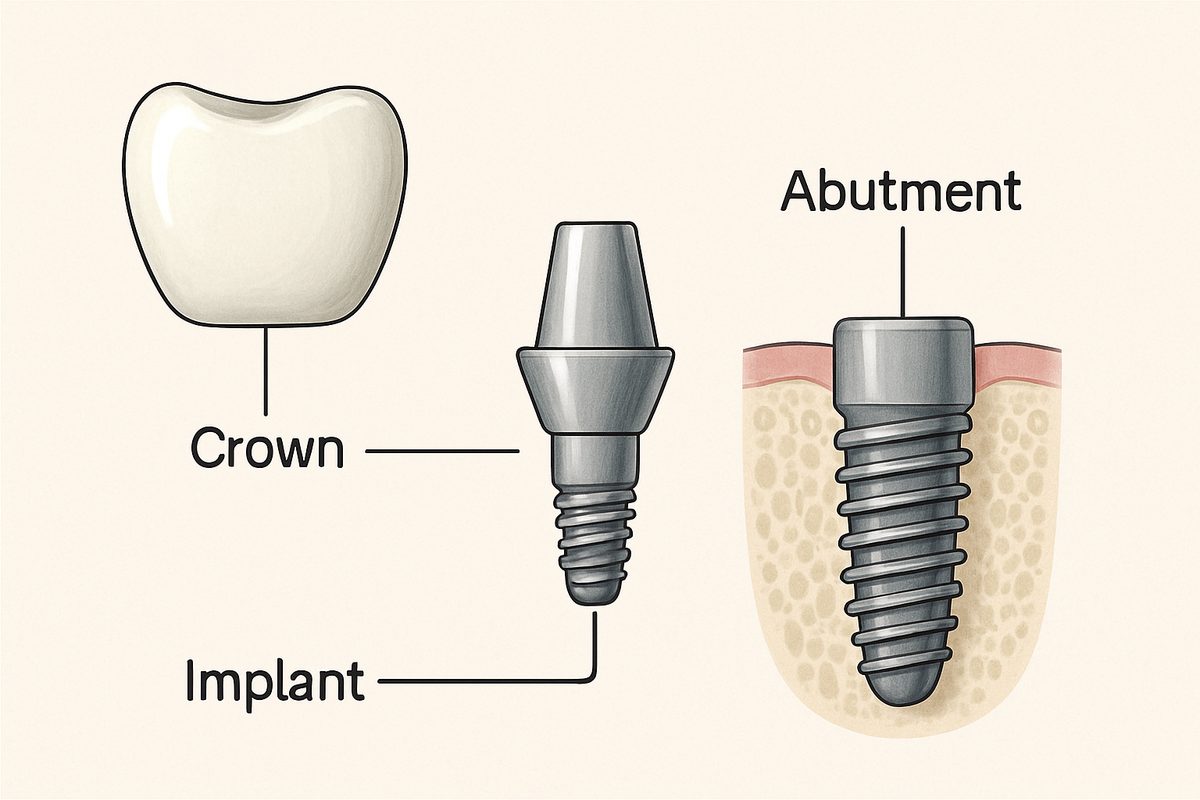Knowing the parts of a tooth implant helps you make smarter choices about your smile and long-term oral health. This post explains each component, how they work together, common problems to watch for, and the questions to ask your dentist about implant care. Read on to learn the key parts of a tooth implant and what they mean for comfort, function, and appearance.
Why Knowing The Parts Of A Tooth Implant Matters
Each part of an implant affects how it feels, how well you chew, how natural it looks, and how much it costs. Understanding the parts helps you compare materials, plan for maintenance, and spot problems early. If you search for “parts of a tooth implant in Jacksonville, FL,” you’ll be better prepared to discuss options and timelines with your dental team.
Main Parts Of A Tooth Implant
The Implant Post (Fixture)
The implant post is the metal or ceramic piece that is placed into the jawbone. It acts like an artificial tooth root and provides the main support. Posts come in different shapes (cylindrical or tapered) and sizes to match bone anatomy. Most posts are made from titanium or zirconia because these materials are strong and bond well with bone.
The Abutment
The abutment connects the post to the replacement tooth. It sits above the gum line and can be straight, angled, or use a multi-unit design for bridges or full-arch work. Abutments may be prefabricated or custom-made to match the final crown and gum contours.
The Prosthetic Tooth (Crown, Bridge, Or Denture)
The prosthetic is the visible part that looks and functions like a tooth. For one missing tooth, a single crown attaches to the abutment. For several missing teeth, implant-supported bridges or dentures attach to multiple abutments or posts. Choices in shape, color, and material affect aesthetics and strength.
Temporary Components And Accessories
During treatment you may receive healing abutments, temporary crowns, or cover screws. Clinics also use impression parts or digital scan components to capture precise measurements. These temporary pieces protect the implant site and shape the gum while the implant heals.
Materials And How They Affect The Parts Of A Tooth Implant
Titanium Vs Zirconia Posts
Titanium is the most common post material. It’s very strong, well-studied, and bonds reliably with bone. Zirconia is metal-free and white, which can be an advantage for thin gums or patients who prefer ceramic. Zirconia can be more aesthetic but may be less forgiving in some surgical situations. If you search for “parts of a tooth implant in Jacksonville, FL,” ask which post material your dentist recommends and why.
Restorative Materials For Crowns
Common crown materials include porcelain-fused-to-metal (PFM), all-porcelain, and solid zirconia. Porcelain offers great color match for front teeth. Zirconia is very strong and is often used for back teeth or bridges. PFM is durable but may show a dark line at the gum over time. Material choice affects look, wear, and cost.
How The Parts Work Together During Placement And Healing
Osseointegration: The Post Bonding To Bone
Osseointegration is the process where bone grows around the implant post, locking it in place. This healing is essential for long-term stability. Titanium and zirconia differ slightly in how they bond, but both aim to achieve strong integration before a permanent restoration is placed.
Timing And Workflow: Same-Day Vs Staged Restorations
Some patients get a temporary tooth the same day as implant placement, while others wait months for a staged approach. Immediate restorations work when the implant is stable enough at placement. Staged restorations let osseointegration finish before adding the final crown. Your dentist will recommend timing based on bone quality, implant stability, and esthetic goals.
Common Problems Linked To Specific Parts
Loose Or Broken Abutment Or Crown
- Cause: improper fit, excessive force, or trauma.
- Fix: tighten or replace screws, repair or remake the crown or abutment.
Peri-Implantitis And Bone Loss Around The Post
Peri-implantitis is infection and inflammation around the post that can lead to bone loss. Prevention includes good oral hygiene, regular cleanings, and early treatment of gum problems. Watch for redness, swelling, bleeding, or loosening.
Wear, Fracture, Or Aesthetic Issues With The Prosthetic Tooth
Crowns can chip, stain, or wear over time. Hard foods and bruxism raise risk. Proper material choice and occasional replacement keep function and appearance optimal.
Questions To Ask Your Dentist About The Parts Of A Tooth Implant
- Which post and crown materials do you recommend and why?
- Who will place the implant and who will restore it?
- What imaging and digital planning do you use?
- What is the expected timeline for healing and final restoration?
- What are the risks, costs, and any warranties or guarantees?
Why Consider West Dentistry For Implants
West Dentistry in Jacksonville, FL offers cosmetic and restorative expertise led by Dr. Jacqueline West, with an on-site oral surgeon, Dr. Victor Erminy. The practice uses digital imaging and an on-site surgical suite to coordinate care, which can simplify treatment and reduce referrals. If you want to learn more about the parts of a tooth implant in Jacksonville, FL and which options fit your needs, West Dentistry can explain materials, timelines, and expected outcomes.
Call To Action
Ready to discuss implant options or ask specific questions about the parts of a tooth implant? Schedule a consultation or request more information to get a personalized plan and clear next steps for your smile.

